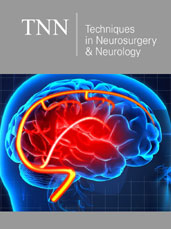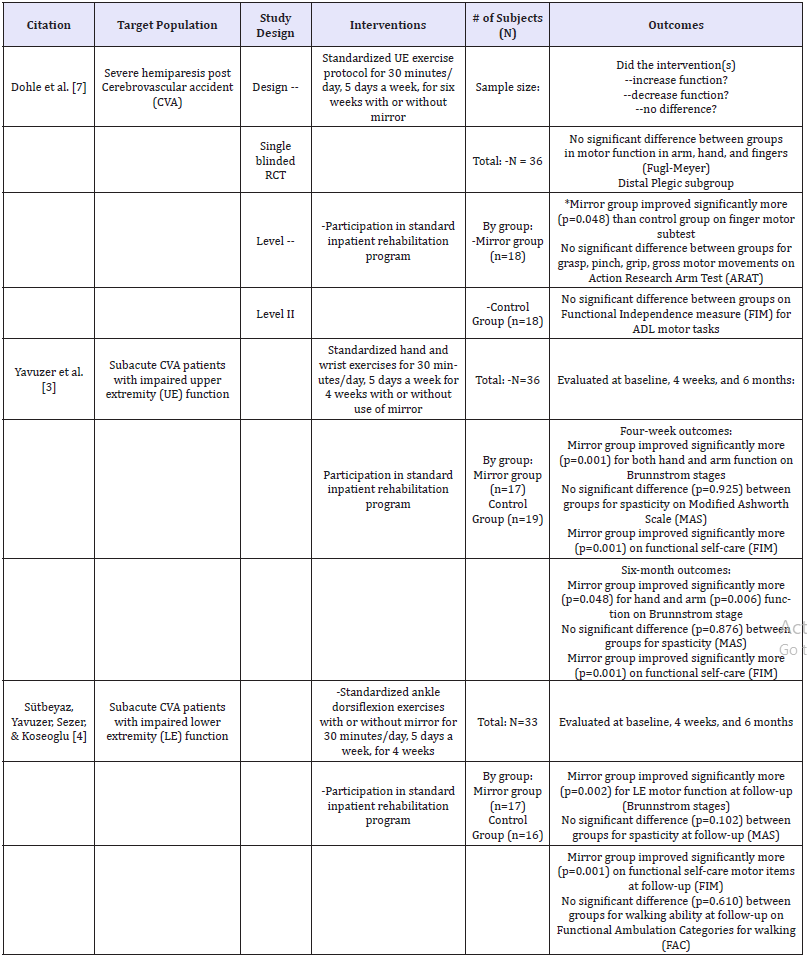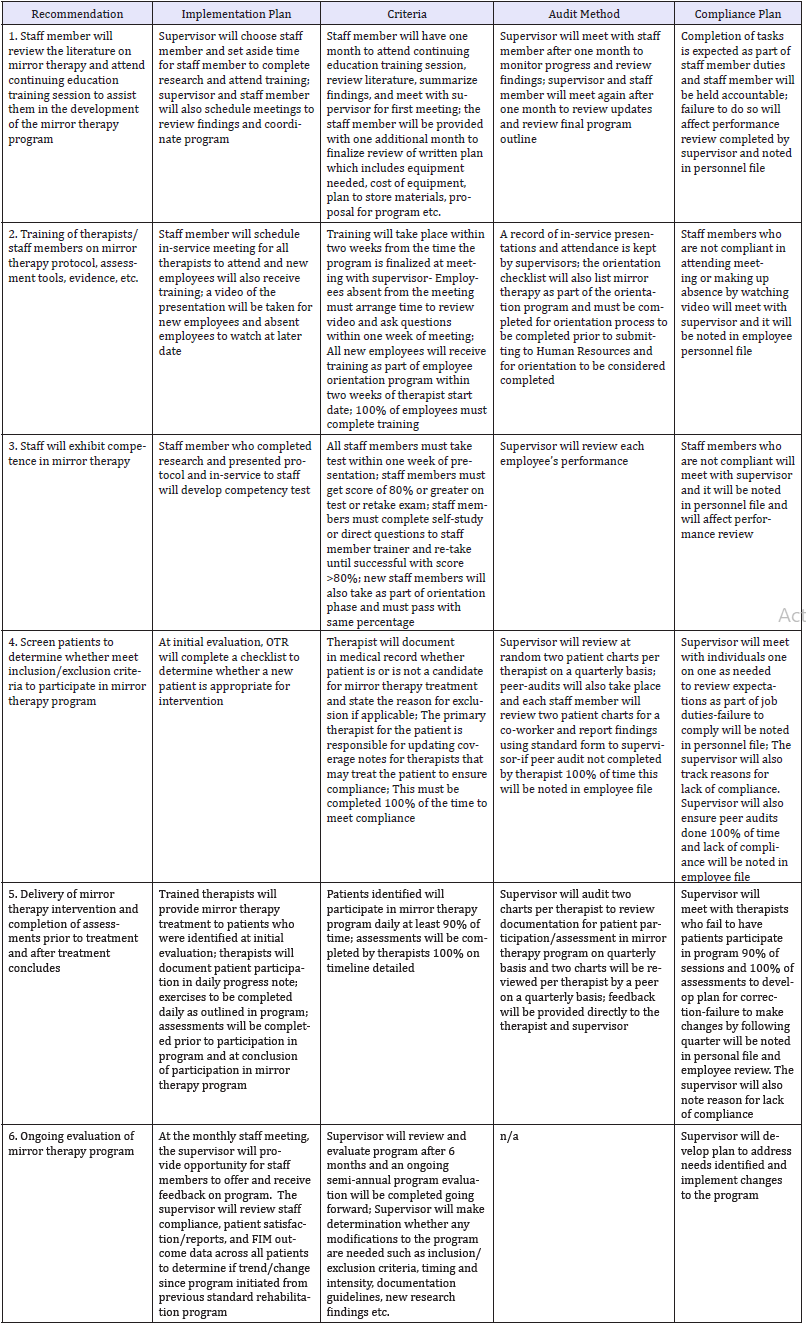- Submissions

Full Text
Techniques in Neurosurgery & Neurology
The Effectiveness of Mirror Therapy with Stroke Patients in Producing Improved Motor and Functional Outcomes
Hassan Izzeddin Sarsak*
Department of Occupational Therapy, University of Jordan, Jordan
*Corresponding author:Sarsak HI, Department of Occupational Therapy, School of Rehabilitation Sciences, Batterjee Medical College, Jeddah, Saudi Arabia
Submission: October 11, 2018;Published: October 26, 2018

ISSN 2637-7748
Volume2 Issue2
Abstract
Objectives: this study was conducted to review the literature on mirror therapy and to examine the scientific evidence on the effectiveness of utilizing mirror therapy to improve motor and functional outcomes with individuals post-stroke.
Results: our review found three studies suggesting that in stroke patients, mirror therapy compared to standardized hand exercise program may lead to improved motor and functional outcomes.
Conclusion: mirror therapy is effective and helpful in improving upper extremity motor and functional outcomes for patients with stroke.
Keywords: Mirror therapy; Hand; Upper extremity; Randomized control; Motor function; Stroke
Introduction
Strokes occur when there is a lack of blood flow to the brain or bleeding that occurs on the brain as a result of a broken blood vessel Gillen & Burkhardt [1]. As a result, the brain does not receive sufficient oxygen and nutrients which results in the death of brain cells which can have profound effects, such as sensorimotor deficits, language deficits, cognitive and visual deficits. Stroke is the leading cause of adult disability in the USA with more than 795, 000 new strokes every year American Heart Association [2]. A study reported that 85% of stroke survivors will have hemiparesis and 55% to 75% will have impaired upper extremity function Yavuzer et al. [3] 2008. Numerous interventions to address these deficits have been used, such as compensatory and remedial strategies for Activities of Daily Living (ADLs), Neurodevelopmental Treatment (NDT), e-stim, bilateral integration, etc. Mirror Therapy is one relatively new intervention utilized to target restoring motor skills with the ideas that improving upper extremity function will also decrease disability.
Mirror therapy in stroke patients involves performing movements of the unimpaired limb while watching its mirror reflection superimposed over the unseen impaired limb, thus creating a visual illusion of enhanced movement capability of the impaired limb and visual feedback for motor relearning Sutbeyaz [4].
The purpose of this study was to review the literature on mirror therapy and to examine the scientific evidence on the effectiveness of utilizing mirror therapy to improve motor and functional outcomes with individuals post-stroke. For the purpose of this study, we created a clinical/research PICO question (Population, Intervention, Comparison, and Outcome), a key to evidence-based decision Richardson [5]. The PICO formed for our study is as follows:
P: In stroke patients,
I: Does mirror therapy and a traditional rehabilitation program
C: Compared to a traditional rehabilitation program and an attention controlled condition
O: Lead to improved motor and functional outcomes?
Methods
Review of literature and search strategy
A research has been made in the following databases: Ovid, MEDLINE, and CINAHL. Keywords and Search items used to search articles for our study were Mirror therapy, hand, upper extremity, randomized control, motor function, and stroke. Four randomized controlled studies produced. Three of the four pertained to PICO question. Based on the hierarchy of levels of evidence in evidence based practice, all three studies were level II single blinded randomized controlled trials (RCTs) Hughes [6]. In reviewing the articles they were summarized in order of publication.
Results
Article evaluation matrix (summary sheet) has been created for reviewed articles in relation to our PICO question (Table 1).
Discussion
Our thorough review revealed that all studies were level II randomized controlled studies. Yavuzer et al. [3] had the largest number of participants and smallest percentage of dropouts. In addition, it evaluated short term and long term outcomes. Sutbeyaz et al. [4] focused on LE function. In Dohle et al. [7], the control group had significantly more (p=0.024) ADL training as part of standard therapy program than mirror group. Therefore, Yavuzer et al. [3] was selected in our study as the strongest evidence. Thus clinical guidelines, recommendations, a plan and audit tool have been developed in our study to implement mirror therapy in clinical setting (Table 2).
Table 1:A summary of articles “Articles Evaluation Matrix” in relation to PICO.

Table 2:A summary of recommendations, plan, and audit tool.

Conclusion
Our review suggests that mirror therapy is effective and helpful in improving upper extremity motor and functional outcomes for patients with stroke. Thus clinical guidelines, recommendations, a plan and audit tool have been created in our study to implement mirror therapy in clinics. The clinical guidelines for recommended intervention, the plan, and the audit tool recommend therapists to apply mirror therapy with individuals post stroke.
References
- Gillen G, Burkhardt A (1998) Stroke rehabilitation: A function based approach. MO: Mosby, Inc. St Louis, Missouri, USA.
- American Heart Association (2006) Know the facts, get the stats 2007. Retrieved February 27, 2010
- Yavuzer G, Selles R, Sezer N, Sütbeyaz S, Bussmann JB, et al. (2008) Mirror therapy improves hand function in subacute stroke: A randomized controlled trial. Arch Phys Med Rehabil 89(3): 393-398.
- Sütbeyaz S, Yavuzer G, Sezer N, Koseoglu F (2007) Mirror therapy enhances lower-extremity motor recovery and motor functioning after stroke: A randomized controlled trial. Arch Phys Med Rehabil 88(5): 555-559.
- Richardson WS, Wilson MC, Nishikawa J, Hayward RS (1995) The wellbuilt clinical question: A key to evidence-based decision. ACP J Club 123(3): A12-A13.
- Hughes I (2006) Action research in healthcare: what is the evidence? ALAR Journal 11(1): 29-39.
- Dohle C, Püllen J, Nakaten A, Küst J, Rietz C, et al. (2009) Mirror therapy promotes recovery from severe hemiparesis: A randomized controlled trial. Neurorehabil Neural Repair 23(3): 209-217.
© 2018 Hassan Izzeddin Sarsak. This is an open access article distributed under the terms of the Creative Commons Attribution License , which permits unrestricted use, distribution, and build upon your work non-commercially.
 a Creative Commons Attribution 4.0 International License. Based on a work at www.crimsonpublishers.com.
Best viewed in
a Creative Commons Attribution 4.0 International License. Based on a work at www.crimsonpublishers.com.
Best viewed in 







.jpg)






























 Editorial Board Registrations
Editorial Board Registrations Submit your Article
Submit your Article Refer a Friend
Refer a Friend Advertise With Us
Advertise With Us
.jpg)






.jpg)














.bmp)
.jpg)
.png)
.jpg)










.jpg)






.png)

.png)



.png)






